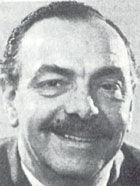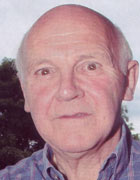2009 Lower Section National Finals - First Section: The none too triumphant cornet cadenzas
30-Sep-2009It was squeaky bum syndrome for principal cornets on Triumphant Rhapsody, as Vinter's famous cadenza made for a very uncomfortable time for those on the end chair.
Even 40 years after his death Gilbert Vinter still has the ability to frighten the life out of players.
Nazi Pope
It’s seems odd that a man who had such a sensitive and sympathetic understanding towards brass bands can induce such feelings of trepidation in players when faced with his glorious music. It’s a bit like finding out that halfway through a sermon the Pope was once a member of the Nazi party…
Vinter was a composer who never deliberately wrote music with the potential to humiliate the players or conductors – he knew only too well that they had the innate ability to do that for themselves.
 Sympathy
Sympathy
It is said that after he adjudicated at the 1964 National Finals on his own ‘Variations on a Ninth’ he vowed never to write a series of cadenzas that so exposed performers to potential disaster again. He is said to have winced repeatedly, not in anger at what he heard at times, but in genuine heartfelt sympathy at what he had put players through.
The cadenzas that feature in his subsequent works are therefore singular affairs – the two cornet features in ‘Triumphant Rhapsody’ and ‘James Cook – Circumnavigator’ perhaps the two most famous examples.
Both serve a very specific musical purpose – unlike many modern ‘quasi cadenzas’ which seem to be pyrotechnic afterthoughts with little relevance to what has gone on before or after them in the score.
Perfect
The cornet cadenza in ‘Triumphant Rhapsody’ is a perfect bridging tool, between the glorious ‘Affetuoso’ grandeur that precedes it and the vibrant ‘Con Brio’ section that follows.
It is difficult – no doubt about it, but surely, given the technical proficiency of today’s performers, it was well within the capabilities of decent principal cornet players with First Section bands.
Not so.
Poor old Gilbert – he must still be wincing up there in the banding heavens.
 James Shepherd
James Shepherd
Some 47 years after it was heard (played first by none other than the great James Shepherd (right) off the number 1 draw with Black Dyke at the Royal Albert Hall, so it must have been a corker) it still saw principal cornets in all sorts of self induced problems.
Not one of the 16 performers on the day (make that 18 as a couple of bands shared it out) managed to play it with the authority and brilliance required, although a few came close.
Varied reasons
The reasons for their problems were varied: poor judgement of pace in the descending triplet motifs, to those who started too slowly and ran out of breath. Many hit an optimum speed too soon and could go no faster, whilst others took longer to slow down than the Queen Mary in reverse gear before the exultant finish.
That final ascending group of seven semi quavers was a minefield too – marked brillante, accented with a crescendo to a fortissimo paused top A and quick diminuendo to pianissimo.
Rizla paper
Sir Alex Ferguson got it right when he talked about ‘squeaky bum syndrome’ – there were times on Sunday afternoon when you could almost visibly see the clenching of the buttocks to such an extent you couldn’t have got a Rizla paper between the cheeks of some backsides.
Before a note was played, some principals took so much time over the tiny comma breath mark that you felt they were opting for a quick prayer to the contesting Gods, whilst others then proceeded so slowly that the first few triplets could have been written in minim beats.
Pensioner pace
Many then hit the accelerator pedal leaving themselves no where to go, whilst others opted for the safety first approach and the type of speed usually observed in pensioners driving around a supermarket car park in an old Rover 25.
The final flourish was invariably anything but.
A few went for it and paid a heavy price for their bravery – a few yodelling efforts and painful splits where on display, but the majority opted for the slow and deliberate climb to the top – complete with safety net and hard hat.
It was hard to recall any player really making the effort to die away to pianissimo too – the dynamic that started the next movement.
In total, the cadenza was just nine bars in length – no higher than a top A, no lower than a bottom C#, to be played with clarity and precision and with a sense of style.
Simple really.
Mayhem
In the end though it caused mayhem – self induced mayhem that is, as a new generation of principal cornet players brought up on the technical wizardry of modern test pieces and pyrotechnic cornet solos found a simple piece of technique, style and musicianship too much for them.
Some left the stage close to tears, others wearing the type of shell shocked expression usually seen on post traumatic stress sufferers.
Question
It begged the question if any of them had actually heard a top class player (and recordings of Jim Shepherd and others are around) playing it over the years, or had they just decided to cross a few fingers, say a prayer and hope for the best.
On the evidence on show on the day only a few enhanced their reputations – and in a few months time ‘English Heritage’ awaits.
Gilbert Vinter can rest easy for another 47 years.
Iwan Fox















